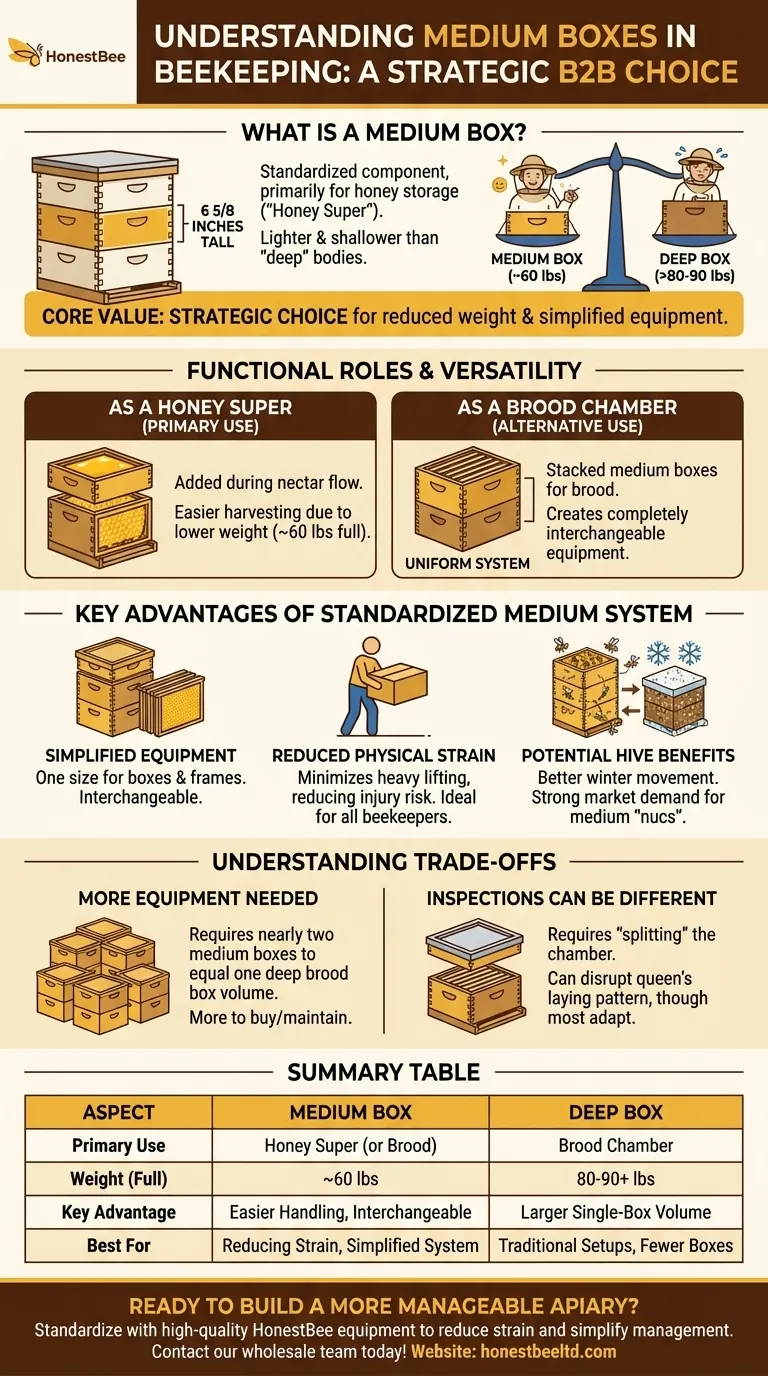In beekeeping, a medium box is a standardized beehive component measuring 6 5/8 inches tall, primarily used for honey storage. Also known as a "honey super," it is placed on top of the main hive for bees to fill with surplus honey. Because it is shallower and lighter than a "deep" hive body, it has become a popular and versatile choice for modern beekeepers.
The core reason to understand medium boxes is that they represent a strategic choice in hive management, trading the larger volume of a deep box for significantly reduced weight and simplified, interchangeable equipment.

The Functional Role of the Medium Box
A medium box can serve two distinct purposes within a beehive, although one is far more common. Its versatility is a key reason for its popularity.
As a Honey Super (Primary Use)
The most common application for a medium box is as a honey super. It is added to the top of the hive during a nectar flow.
Worker bees use the frames inside this box to build comb and store the surplus honey that the beekeeper will eventually harvest.
Because a full medium box weighs around 60 pounds, it is considerably easier and safer to lift and handle than a deep box, which can exceed 80-90 pounds. This makes honey harvesting a much more manageable task.
As a Brood Chamber (Alternative Use)
Some beekeepers opt to use medium boxes for everything, including the brood chamber where the queen lays her eggs and raises young bees.
In this system, a brood chamber might consist of two or even three stacked medium boxes to provide adequate space for the colony. This creates a completely uniform hive where all boxes and frames are identical and interchangeable.
Key Advantages of a Standardized Medium System
Choosing to use only medium boxes for both brood and honey offers several distinct operational advantages that appeal to many beekeepers.
Simplified Equipment
When every box in your apiary is the same size, management becomes much simpler.
Frames of honey, pollen, or brood can be moved between any boxes in the hive. You only need to buy, build, and store one size of box and one size of frame.
Reduced Physical Strain
This is the most significant benefit. Beekeeping involves heavy lifting, and minimizing weight can prevent injury and make the work more enjoyable, especially for beekeepers with physical limitations.
Standardizing on the lighter medium box makes every hive inspection and harvest less physically demanding.
Potential Hive Benefits
A system of stacked medium brood boxes creates more horizontal gaps in the brood nest. Some believe this allows the winter bee cluster to move more freely between frames and up through the hive to access honey stores.
Furthermore, for beekeepers who plan to sell bees, there is often a strong market demand for nucleus hives (or "nucs") built in medium-sized equipment.
Understanding the Trade-offs
While advantageous, using an all-medium system is not without its considerations. It's a strategic choice with clear trade-offs compared to the traditional deep box setup.
More Equipment is Needed
To equal the volume of one deep brood box, you need nearly two medium boxes. This means you have more equipment to purchase, maintain, and inspect.
Inspections Can Be Different
Inspecting a two-box brood chamber requires you to "split" the chamber to examine the lower box. This can be more disruptive to the colony than simply pulling frames from a single, large brood box.
The gap between the boxes can also interrupt the queen's laying pattern, though most modern queens adapt without issue.
Making the Right Choice for Your Apiary
The decision between using medium boxes, deep boxes, or a combination of both depends entirely on your personal goals and physical capabilities.
- If your primary focus is ease of use and physical safety: A standardized, all-medium-box system is the superior choice for reducing lifting strain and simplifying equipment.
- If your primary focus is a traditional setup or minimizing the number of boxes: Using a deep box for the brood chamber and medium boxes for honey supers is the most common configuration in beekeeping.
Ultimately, the best hive configuration is the one that allows you to manage your bees safely and effectively.
Summary Table:
| Aspect | Medium Box | Deep Box |
|---|---|---|
| Primary Use | Honey Super | Brood Chamber |
| Weight (Full) | ~60 lbs | 80-90+ lbs |
| Key Advantage | Easier handling, interchangeable frames | Larger single-box volume |
| Best For | Reducing physical strain, simplified equipment | Traditional setups, minimizing box count |
Ready to build a more manageable apiary? Standardizing your operation with medium boxes from HONESTBEE can transform your beekeeping. We supply commercial apiaries and distributors with the high-quality, uniform equipment needed to reduce lifting strain and simplify hive management. Contact our wholesale team today to discuss how our beekeeping supplies can benefit your operation.
Visual Guide

Related Products
- Australian Langstroth Beehive Boxes for Beekeeping Wholesales
- Langstroth Bee Hives Bee Keeping Box for Beginners Beekeeping
- Langstroth Honey Bee Box Hive Boxes for Different Depths
- HONESTBEE Professional Long Handled Hive Tool with Precision Cutting Blade
- Portable Bee Mating Hive Boxes Mini Mating Nucs 8 Frames for Queen Rearing
People Also Ask
- What are the three types of beehives? Find the Perfect Hive for Your Beekeeping Philosophy
- What is the purpose of reversing brood chambers in the spring? A Proactive Swarm Prevention Strategy
- How many deep hive bodies should I use? The Standard for a Healthy, Winter-Ready Colony
- What are beehive boxes, and what are they used for? The Essential Guide to Hive Components
- How many frames fit into a standard beehive box? Choose Between 8-Frame and 10-Frame Hives



















